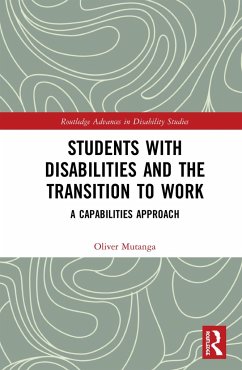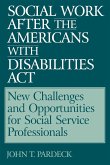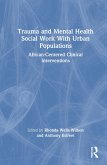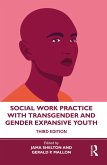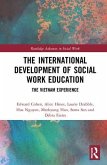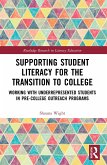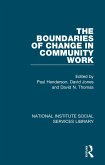- Gebundenes Buch
- Merkliste
- Auf die Merkliste
- Bewerten Bewerten
- Teilen
- Produkt teilen
- Produkterinnerung
- Produkterinnerung
This book sets out to understand how students with disabilities experience higher education and the transition to the workplace.
Andere Kunden interessierten sich auch für
![Social Work After the Americans with Disabilities ACT Social Work After the Americans with Disabilities ACT]() John T. PH. D . PardeckSocial Work After the Americans with Disabilities ACT52,99 €
John T. PH. D . PardeckSocial Work After the Americans with Disabilities ACT52,99 €![Trauma and Mental Health Social Work With Urban Populations Trauma and Mental Health Social Work With Urban Populations]() Trauma and Mental Health Social Work With Urban Populations204,99 €
Trauma and Mental Health Social Work With Urban Populations204,99 €![Social Work Practice with Transgender and Gender Expansive Youth Social Work Practice with Transgender and Gender Expansive Youth]() Social Work Practice with Transgender and Gender Expansive Youth36,99 €
Social Work Practice with Transgender and Gender Expansive Youth36,99 €![The International Development of Social Work Education The International Development of Social Work Education]() Edward CohenThe International Development of Social Work Education205,99 €
Edward CohenThe International Development of Social Work Education205,99 €![Supporting Student Literacy for the Transition to College Supporting Student Literacy for the Transition to College]() Shauna WightSupporting Student Literacy for the Transition to College59,99 €
Shauna WightSupporting Student Literacy for the Transition to College59,99 €![The Boundaries of Change in Community Work The Boundaries of Change in Community Work]() The Boundaries of Change in Community Work49,99 €
The Boundaries of Change in Community Work49,99 €![The Social Work Business The Social Work Business]() John HarrisThe Social Work Business66,99 €
John HarrisThe Social Work Business66,99 €-
-
-
This book sets out to understand how students with disabilities experience higher education and the transition to the workplace.
Hinweis: Dieser Artikel kann nur an eine deutsche Lieferadresse ausgeliefert werden.
Hinweis: Dieser Artikel kann nur an eine deutsche Lieferadresse ausgeliefert werden.
Produktdetails
- Produktdetails
- Verlag: Routledge
- Seitenzahl: 166
- Erscheinungstermin: 19. Juli 2019
- Englisch
- Abmessung: 240mm x 161mm x 14mm
- Gewicht: 420g
- ISBN-13: 9781138611825
- ISBN-10: 1138611824
- Artikelnr.: 57176145
- Herstellerkennzeichnung
- Libri GmbH
- Europaallee 1
- 36244 Bad Hersfeld
- gpsr@libri.de
- Verlag: Routledge
- Seitenzahl: 166
- Erscheinungstermin: 19. Juli 2019
- Englisch
- Abmessung: 240mm x 161mm x 14mm
- Gewicht: 420g
- ISBN-13: 9781138611825
- ISBN-10: 1138611824
- Artikelnr.: 57176145
- Herstellerkennzeichnung
- Libri GmbH
- Europaallee 1
- 36244 Bad Hersfeld
- gpsr@libri.de
Oliver Mutanga is a Research Fellow at University College London. He is also an Expert Evaluator for the European Commission. His research interests are Disability and Health. He was awarded a scholarship at the University of the Free State in South Africa to pursue doctoral studies (2013- 2016). In 2015, he was awarded a CICOPS Fellowship by the University of Pavia, Italy. In 2017, he was awarded a Marie Sklodowska Curie Postdoctoral Fellowship at the University of Oslo, Norway. Prior to his PhD research, he worked as a Researcher in Zimbabwe, Botswana and South Africa.
List of figures and tables
Acknowledgements
List of abbreviations
Chapter 1: Introduction
The study
Structure of the book
Notes
References
Chapter 2: Students with Disabilities in Higher Education: A Global Perspective
Introduction
Perceptions and Experiences of students with disabilities in higher education
Higher Education Institutions' responses to the needs of students with disabilities
Discussion
Conclusion
Notes
References
Chapter 3: Students with Disabilities in Southern African Higher Education
Introduction
Conceptualising disability
Students' with disabilities' access and participation in higher education
Supporting mechanisms for students with disabilities
Discussion
Conclusion
References
Chapter 4: Disability Models or Approaches
Introduction
The Medical Model
The Social Model
The International Classification of Functioning, Disability and Health (ICF)
The Human Rights Approach
Conclusion
References
Chapter 5: Capability Approaches
Introduction
Theory of participatory parity
Conclusion
Notes
References
Chapter 6: Disabled or not disabled?
Introduction
Conceptualising disability
Findings
Discussion
Conclusion
References
Chapter 7: Inclusion of students with disabilities in Higher Education
Introduction
Inclusion and exclusion
Findings
Discussion
Conclusion
References
Chapter 8: Factors affecting the lives of students with disabilities at university
Introduction
Intersectionality and Disability Studies
Findings
Discussion
Conclusion
References
Chapter 9: Resilience and coping strategies
Introduction
Coping mechanisms
Findings
Discussion
Conclusion
References
Chapter 10: Valued opportunities: an inclusive Higher Education Policy through the Capability Approaches
Introduction
Capabilities Approach, Disability and the Dilemma of Difference
Findings
Capabilities and Valued Functionings
Capabilities from Wolff and De-Shalit's (2007) list
Additional Higher Education Capabilities
Discussion
Conclusion
References
Chapter 11: Youth with disabilities and their transition to employment
Introduction
Findings
Discussion
Conclusion
References
Chapter 12: Beyond the Convention on the Rights of Persons with Disabilities (CRPD) and Sustainable Development Goals (SDGs)
Introduction
National and International Disability Frameworks
Possibilities and ways forward
Conclusion
References
Index
Acknowledgements
List of abbreviations
Chapter 1: Introduction
The study
Structure of the book
Notes
References
Chapter 2: Students with Disabilities in Higher Education: A Global Perspective
Introduction
Perceptions and Experiences of students with disabilities in higher education
Higher Education Institutions' responses to the needs of students with disabilities
Discussion
Conclusion
Notes
References
Chapter 3: Students with Disabilities in Southern African Higher Education
Introduction
Conceptualising disability
Students' with disabilities' access and participation in higher education
Supporting mechanisms for students with disabilities
Discussion
Conclusion
References
Chapter 4: Disability Models or Approaches
Introduction
The Medical Model
The Social Model
The International Classification of Functioning, Disability and Health (ICF)
The Human Rights Approach
Conclusion
References
Chapter 5: Capability Approaches
Introduction
Theory of participatory parity
Conclusion
Notes
References
Chapter 6: Disabled or not disabled?
Introduction
Conceptualising disability
Findings
Discussion
Conclusion
References
Chapter 7: Inclusion of students with disabilities in Higher Education
Introduction
Inclusion and exclusion
Findings
Discussion
Conclusion
References
Chapter 8: Factors affecting the lives of students with disabilities at university
Introduction
Intersectionality and Disability Studies
Findings
Discussion
Conclusion
References
Chapter 9: Resilience and coping strategies
Introduction
Coping mechanisms
Findings
Discussion
Conclusion
References
Chapter 10: Valued opportunities: an inclusive Higher Education Policy through the Capability Approaches
Introduction
Capabilities Approach, Disability and the Dilemma of Difference
Findings
Capabilities and Valued Functionings
Capabilities from Wolff and De-Shalit's (2007) list
Additional Higher Education Capabilities
Discussion
Conclusion
References
Chapter 11: Youth with disabilities and their transition to employment
Introduction
Findings
Discussion
Conclusion
References
Chapter 12: Beyond the Convention on the Rights of Persons with Disabilities (CRPD) and Sustainable Development Goals (SDGs)
Introduction
National and International Disability Frameworks
Possibilities and ways forward
Conclusion
References
Index
List of figures and tables
Acknowledgements
List of abbreviations
Chapter 1: Introduction
The study
Structure of the book
Notes
References
Chapter 2: Students with Disabilities in Higher Education: A Global Perspective
Introduction
Perceptions and Experiences of students with disabilities in higher education
Higher Education Institutions' responses to the needs of students with disabilities
Discussion
Conclusion
Notes
References
Chapter 3: Students with Disabilities in Southern African Higher Education
Introduction
Conceptualising disability
Students' with disabilities' access and participation in higher education
Supporting mechanisms for students with disabilities
Discussion
Conclusion
References
Chapter 4: Disability Models or Approaches
Introduction
The Medical Model
The Social Model
The International Classification of Functioning, Disability and Health (ICF)
The Human Rights Approach
Conclusion
References
Chapter 5: Capability Approaches
Introduction
Theory of participatory parity
Conclusion
Notes
References
Chapter 6: Disabled or not disabled?
Introduction
Conceptualising disability
Findings
Discussion
Conclusion
References
Chapter 7: Inclusion of students with disabilities in Higher Education
Introduction
Inclusion and exclusion
Findings
Discussion
Conclusion
References
Chapter 8: Factors affecting the lives of students with disabilities at university
Introduction
Intersectionality and Disability Studies
Findings
Discussion
Conclusion
References
Chapter 9: Resilience and coping strategies
Introduction
Coping mechanisms
Findings
Discussion
Conclusion
References
Chapter 10: Valued opportunities: an inclusive Higher Education Policy through the Capability Approaches
Introduction
Capabilities Approach, Disability and the Dilemma of Difference
Findings
Capabilities and Valued Functionings
Capabilities from Wolff and De-Shalit's (2007) list
Additional Higher Education Capabilities
Discussion
Conclusion
References
Chapter 11: Youth with disabilities and their transition to employment
Introduction
Findings
Discussion
Conclusion
References
Chapter 12: Beyond the Convention on the Rights of Persons with Disabilities (CRPD) and Sustainable Development Goals (SDGs)
Introduction
National and International Disability Frameworks
Possibilities and ways forward
Conclusion
References
Index
Acknowledgements
List of abbreviations
Chapter 1: Introduction
The study
Structure of the book
Notes
References
Chapter 2: Students with Disabilities in Higher Education: A Global Perspective
Introduction
Perceptions and Experiences of students with disabilities in higher education
Higher Education Institutions' responses to the needs of students with disabilities
Discussion
Conclusion
Notes
References
Chapter 3: Students with Disabilities in Southern African Higher Education
Introduction
Conceptualising disability
Students' with disabilities' access and participation in higher education
Supporting mechanisms for students with disabilities
Discussion
Conclusion
References
Chapter 4: Disability Models or Approaches
Introduction
The Medical Model
The Social Model
The International Classification of Functioning, Disability and Health (ICF)
The Human Rights Approach
Conclusion
References
Chapter 5: Capability Approaches
Introduction
Theory of participatory parity
Conclusion
Notes
References
Chapter 6: Disabled or not disabled?
Introduction
Conceptualising disability
Findings
Discussion
Conclusion
References
Chapter 7: Inclusion of students with disabilities in Higher Education
Introduction
Inclusion and exclusion
Findings
Discussion
Conclusion
References
Chapter 8: Factors affecting the lives of students with disabilities at university
Introduction
Intersectionality and Disability Studies
Findings
Discussion
Conclusion
References
Chapter 9: Resilience and coping strategies
Introduction
Coping mechanisms
Findings
Discussion
Conclusion
References
Chapter 10: Valued opportunities: an inclusive Higher Education Policy through the Capability Approaches
Introduction
Capabilities Approach, Disability and the Dilemma of Difference
Findings
Capabilities and Valued Functionings
Capabilities from Wolff and De-Shalit's (2007) list
Additional Higher Education Capabilities
Discussion
Conclusion
References
Chapter 11: Youth with disabilities and their transition to employment
Introduction
Findings
Discussion
Conclusion
References
Chapter 12: Beyond the Convention on the Rights of Persons with Disabilities (CRPD) and Sustainable Development Goals (SDGs)
Introduction
National and International Disability Frameworks
Possibilities and ways forward
Conclusion
References
Index

